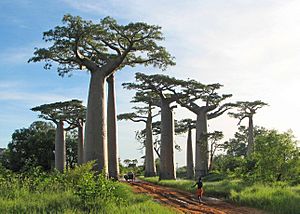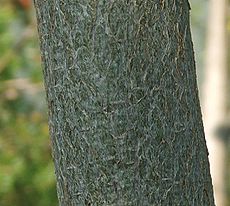Adansonia grandidieri facts for kids
Quick facts for kids Adansonia grandidieri |
|
|---|---|
 |
|
| Conservation status | |
| Scientific classification | |
| Genus: |
Adansonia
|
| Species: |
grandidieri
|
Adansonia grandidieri is the largest and most well-known of the six types of baobab trees found in Madagascar. People often call it Grandidier's baobab or the giant baobab. In French, it's known as Baobab malgache. Locals call it renala or reniala, which means "mother of the forest".
This amazing tree grows only on the island of Madagascar. It is an endangered species, mainly because its home is being turned into farmland. You can see these famous trees at the Avenue of the Baobabs.
Contents
What Does It Look Like?
Grandidier's baobabs have huge, round, thick trunks. These trunks can be up to three meters (about 10 feet) wide. They are covered with smooth, reddish-grey bark. These trees can grow very tall, reaching 25 to 30 meters (82 to 98 feet) in height. The top of the tree is flat, with main branches spreading out sideways.
Leaves
The leaves of this baobab look like a hand with fingers. They usually have 9 to 11 small leaves, called leaflets. This is the only baobab species with blue-green leaflets. These leaflets are also covered with tiny, star-shaped hairs.
Flowers
These baobabs flower during the dry season, from May to August. This happens before the leaves even appear. The flower buds stand upright and are dark brown and round.
Each flower has 5 (sometimes 3) parts called calyx lobes. These lobes bend back and twist at the flower's base. They join together at the bottom, forming a small cup. The petals are white and turn yellow as they get older. They are about 20 mm (0.8 inches) long.
The flowers have a white central tube, called a staminal tube. It is up to 16 mm (0.6 inches) long. This tube is made of fused stalks that hold the pollen-producing parts (stamens). About 600 to 700 unfused stalks, up to 6.5 cm (2.5 inches) long, spread out from the top of this tube. Inside the staminal tube is a very hairy part called the ovary. A long style, topped with a white or pinkish stigma, comes out from the stalks.
Fruits and Seeds
The fruits of the Grandidier's baobab are large and dry. They are round or egg-shaped. They have a hard shell, about 2 to 4.5 mm (0.08 to 0.18 inches) thick. This shell is covered with thick, reddish-brown hairs. Inside, there are large, kidney-shaped seeds. These seeds are 12 to 20 mm (0.5 to 0.8 inches) long. They are found within an edible pulp.
Where Do They Live?
This baobab tree grows in the southwestern part of Madagascar. You can find it between Lac Ihotry, near Morombe, and Bereboka. Grandidier's baobab used to live in dry, deciduous forests. These forests were often near seasonal rivers or lakes. Today, however, you mostly find them in open farmland. They also grow in damaged scrubland.
Life Cycle and How They Grow
The Grandidier's baobab lives for a very long time. It has leaves from October to May. It flowers between May and August. People say the flowers smell like sour watermelon. The flowers open just before or after sunset. All their pollen is released during the first night.
The tree is pollinated by animals that are active at night. These include fork-marked lemurs and insects like the Hawk Moth. Lemurs move through the treetops. They put their noses into the white flowers and lick nectar. This causes pollen to stick to their faces. Hawk Moths are even better at pollination. They can fly from tree to tree with most of their bodies covered in pollen.
The tree produces ripe fruit in November and December. Unlike baobabs in Africa and Australia, it seems animals do not spread the seeds of this tasty fruit. Lemurs are the only animals in Madagascar alive today that could spread the seeds. However, no one has seen them do it.
In the past, things might have been different. Several animal species have died out since humans came to the island (1,500 to 2,000 years ago). These animals could have spread the seeds. This includes types of primates similar to baboons. It also includes the heaviest bird ever, the elephant bird. This bird had a strong beak that could have opened large fruits. Today, water might be how the seeds are spread.
Sometimes, plants in Madagascar don't get enough water. The baobab solves this problem by storing water in its trunk's fibrous wood. The tree's width actually changes depending on how much rain falls.
Tree Names and Family
Adansonia grandidieri was first described by a botanist named Henri Ernest Baillon. He published his findings in 1888. The name of the group of trees, Adansonia, honors a French explorer and botanist, Michel Adanson. The species name, grandidieri, honors another French botanist and explorer, Alfred Grandidier.
All types of Adansonia trees, except for A. digitata, are diploid. This means they have two sets of chromosomes. The Adansonia group belongs to the subfamily Bombacoideae. This is part of the plant family Malvaceae, which is in the order Malvales. Adansonia grandidieri is grouped with its close relative, Adansonia suarezensis. These are large baobabs with egg-shaped flower buds on short, upright stalks.
How People Use It
This baobab is the most used of all the baobabs in Madagascar. People eat the seeds and the fruit pulp, which is rich in vitamin C. They eat them fresh. Cooking oil is also made from the oily seeds.
People collect the fruit either from the ground or by climbing the tree. To climb, they hammer wooden pegs into the trunk. The baobab's thick bark has strong, long fibers. These fibers are used to make ropes. Most trees have scars where bark was cut from the ground up to about two meters high. The spongy wood is made of fiber sheets. These are collected from dead or living trees. They are dried in the sun and sold for thatch, which is used for roofs. Most of these uses do not kill the tree. So, they are not a big threat to the baobab.
Dangers and Protection

The IUCN Red List classified Grandidier's baobab as endangered in 2006. Even though people use this baobab a lot, the biggest danger is its forest home being turned into farmland. In these changed areas, there are very few young baobab trees.
Fires, animals eating seeds, competition from weeds, and changes to the environment might stop the baobab from reproducing. This could be very bad for its survival. In 2003, the President of Madagascar promised to triple the number of protected areas. This could help the Grandidier's baobab.
The famous group of Grandidier's baobabs at the Avenue of the Baobabs has been a focus of local protection efforts. In July 2007, the Ministry of Environment, Water and Forests gave it temporary protected status. This is a step towards making it Madagascar's first natural monument.
See also
 In Spanish: Adansonia grandidieri para niños
In Spanish: Adansonia grandidieri para niños



